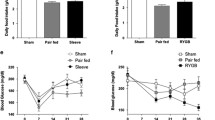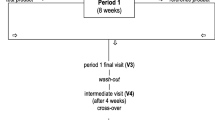Abstract
Serum cholesterol values were insufficiently reduced by pravastatin in two different patient populations. Therefore, we studied whether further cholesterol reduction could be achieved by inhibiting both cholesterol synthesis (by pravastatin) and absorption (by neomycin or sitostanol ester). Thus, we measured serum cholesterol, cholesterol precursors (reflecting cholesterol synthesis), cholestanol and plant sterols (reflecting cholesterol absorption and biliary secretion) for up to 6 weeks in pravastatin-treated patients with familial hypercholesterolaemia (FH, n=13) and with and without ileal bypass during addition of neomycin (1.5 g per day) and in another patient population of non-FH (n=14) subjects during addition of sitostanol ester (1.5 g per day).
Addition of neomycin lowered serum total, LDL and HDL cholesterol by a further 20 %, and increased the pravastatin-lowered precursor:cholesterol ratios by 20 % (irrespective of ileal bypass). It also reduced by 20 % the plant sterol:cholesterol ratio (irrespective of ileal bypass) which was markedly increased by pravastatin alone. Pravastatin and neomycin in combination lowered total, LDL and HDL cholesterol by 45 %, 53 % and 17 %, respectively. This combined regimen reduced the serum lathosterol:cholesterol ratio to about half of the reduction caused by pravastatin, while the elevation of the plant sterols:cholesterol ratio was less with the combination than with pravastatin alone. Changes in serum cholesterol precursor:cholesterol and plant sterol:cholesterol ratios during the combined treatment were smaller in the subgroup with ileal bypass. Addition of sitostanol ester did not lower serum total or LDL cholesterol nor the precursor:cholesterol ratios significantly, while the reduction observed in the plant sterols:cholesterol ratios was similar to that achieved with neomycin addition.
These findings suggest that simultaneous inhibition of cholesterol synthesis and absorption very effectively reduced serum cholesterol levels and that the addition of neomycin or sitostanol ester reduced cholesterol absorption, while the addition of sitostanol ester reduced serum cholesterol and, compensatorily, increased cholesterol synthesis less consistently than neomycin.
Similar content being viewed by others
References
Miettinen TA (1990) Combined drug treatment of hyperlipidemia. Curr Opin Lipidol 1:39–42
Uusitupa MJ, Miettinen TA, Happonen P, et al (1992) Lathosterol and other noncholesterol sterols during treatment of hypercholesterolaemia with lovastatin alone and with cholestyramine or guar gum. Arteriorscler Thromb 12:807–13
Lipid Research Clinics Program (1984) The Lipid Research Clinics Coronary Primary Prevention Trial results. II. The relationship of reduction in incidence of coronary heart disease to cholesterol lowering. JAMA 251:365–374
Schede RWB, Van't Laar A, Majoor CLH, Jansen AP (1976) A comparative study of the effects of cholestyramine and neomycin in the treatment of type II hyperlipoproteinemia. Acta Med Scand 199:175–180
Schaefer EJ (1986) Lipid lowering agents other than anion exchange resins which affect the gastrointestinal system. In: Levy RI, Shepher J, Packard CJ, Miller NE (eds) Pharmacological control of hyperlipidemia. Prous, Barcelona, pp 119–132
Hoeg JM, Maher MB, Bou E, et al (1984) Normalization of plasma lipoprotein concentrations in patients with type II hyperlipoproteinemia by combined use of neomycin and niacin. Circulation 70:1004–1011
Hoeg JM, Maher MB, Bailey KR, et al (1985) Effects of combination cholestyramine-neomycin treatment on plasma lipoprotein concentrations in type II hyperlipoproteinemia. Am J Cardiol 55:1282–1286
Thompson GR, Barrowman J, Gutierrez L, Dowling RH (1971) Action of neomycin on the intraluminal phase of lipid absorption. J Clin Invest 50:319–323
Miettinen TA (1979) Effects of neomycin alone and in combination with cholestyramine on serum cholesterol and fecal steroids in hypercholesterolaemic subjects. J Clin Invest 64:1485–1493
Sedaghat A, Samuel P, Crouse JR, Ahrens EH Jr (1975) Effects of neomycin on absorption, synthesis and/or flux of choleserol in man. J Clin Invest 55:12–21
Heinemann T, Kullak-Ublick G-K, Pietruck B, Bergman K von (1991) Mechanisms of action of plant sterols on inhibition of cholesterol absorption. Eur J Clin Pharmacol 40, [Suppl 1] 50–63
Miettinen TA, Vanhanen H (1994) Dietary sitostanol related to absorption, synthesis and serum level of cholesterol in different apoprotein E phenotypes. Atherosclerosis 105:217–226
Samuel P, Waithe WI (1961) Reduction of serum cholesterol concentrations by neomycin, para-amonosalicylic acid and other antibacterial drugs in man. Circulation 24:578–591
Fields RL (1964) Neomycin ototoxicity. Arch Otolaryngol 79:67–70
Greenberg LH, Momary H (1965) Audiotoxicity and nephrotoxicity due to orally administered neomycin. JAMA 194:827–828
Samuel P, Holtzman CM, Meilman E, Sekowski I (1970) Reduction of serum cholesterol and triglyceride levels by the combined administration of neomycin and clofibrate. Circulation 41:109–114
Breen KJ, Bryant EE, Levinson JD, Shenker S (1972) Neomycin absorption in man. Ann Int Med 76: 211–218
Hoeg JM, Schaefer EJ, Romano CA, et al (1984) Neomycin and plasma lipoproteins in type II hyperlipoproteinemia. Clin Pharmacol Ther 36:555–565
Gurakar A, Hoeg JM, Kostner G, Papadopoulos NM, Brewer HB Jr (1985) Levels of lipoprotein Lp(a) decline with neomycin and niacin treatment. Atherosclerosis 57:293–301
Kesäniemi YA, Grundy SM (1984) Turnover of low density lipoprotein during inhibition of cholesterol absorption by neomycin. Arteriosclerosis 4:41–48
Slota T, Kozlov NA, Ammon HA (1983) Comparison of cholesterol and β-sitosterol: effects of jejunal fluid secretion induced by oleate, and absorption from mixed micellar solutions. Gut 24:653–658
Ikeda I, Tanaka K, Sugano M, Vahouny GV, Gallo LL (1988) Discrimination between cholesterol and sitosterol for absorption in rats. J Lipid Res 29:1583–1592
Ikeda I, Tanaka K, Sugano M, Vahouny GV, Gallo IL (1988) Inhibition of cholesterol absorption in rats by plant sterols. J Lipid Res 29:1573–1582
Ikeda I, Tanake Y, Sugano M (1989) Effects of sitosterol and sitostanol on micellar solubility of cholesterol. J Nutr Sci Vitaminol (Tokyo) 35:361–369
Miettinen TA, Siurala M (1971) Bile salts, sterols, sterol esters, glycerides and fatty acids in micellar and oil phases of intestinal contents during fat digestion in man. Z Klin Chem Biochem 9: 47–52
Grundy SM, Mok, HYI (1976) Effects of low dose phytosterols on cholesterol absorption in man. In: Greten H (ed) Lipoprotein metabolism. Springer, Berlin Heidelberg New York, pp 112–118
Kudchodkar BJ, Horlick L, Sodhi HS (1976) Effects of plant sterols on cholesterol metabolism in man. Atherosclerosis 23:239
Mattson FH, Volpenhein RA, Erickson BA (1977) Effect of plant sterol esters on the absorption of dietary cholesterol. J Nutr 107:1139–1146
Mattson FH, Grundy SM, Crouse JR (1982) Optimizing the effect of plant sterols on cholesterol absorption in man. Am J Clin Nutr 35:697–700
Hassan AS, Rampone AJ (1979) Intestinal absorption and lymphatic transport of cholesterol and β-sitostanol in the rat. J Lipid Res 20:646–653
Vanhanen HT, Miettinen TA (1992) Effects of unsaturated and saturated dietary plant sterols on their serum contents. Clin Chim Acta 205:97–107
Vanhanen HT, Blomqvist S, Ehnholm C, Hyvönen M, Jauhiainen M, Torstila I, Miettinen TA (1993) Sitostanol ester in dietary oil reduces serum cholesterol. Effects on serum plant sterols and cholesterol precursors. J Lipid Res 34: 1535–1544
Gylling H, Miettinen TA (1992) Serum cholesterol lowering by dietary sitostanol is associated with reduced absorption and enhanced synthesis of cholesterol with subsequently alterd LDL apo B kinetics in type II diabetic men. Circulation 86:I-404
Heinemann T, Leiss O, Bergman K von (1986) Effects of low-dose sitostanol on serum cholesterol in patients with hypercholesterolaemia. Atherosclerosis 61:219–223
Vanhanen HT, Kajander J, Lehtovirta H, Miettinen TA (1994) Serum levels, absorption efficiency, fecal elimination and synthesis of cholesterol during increasing doses of dietary sitostanol esters in hypercholesterolaemic subjects. Clin Sci 87: 61–67
Friedewald WT, Levy RI, Fredrickson SS (1972) Estimation of the concentrations of low-density-lipoprotein cholesterol in plasma without use of the preparative ultracentrifuge. Clin Chem 18: 499
Miettinen TA (1982) Gas-liquid chromatographic determination of fecal neutral sterols using a capillary column. Clin Chim Acta 124:245–248
Miettinen TA, Koivisto P (1983) Non-cholesterol sterols and bile-acid production in hypercholesterolaemic patients with ileal bypass. In: Paumgartner G, Stiehl A, Gerok W (eds) Bile acids and cholesterol in health and disease. MTP, Lancaster, pp 183–187
Miettinen TA (1970) Detection of changes in human cholesterol metabolism. Ann Clin Res 2: 300–320
Kempen HJM, Glatz JFC, Leuven JAG, Voort HA van der, Katan MB (1988) Serum lathosterol concentration is an indicator of whole-body cholesterol synthesis in humans. J Lipid Res 29:1149–1151
Björkhem I, Miettinen TA, Reihner E, Ewert S, Angelin B, Einarsson K (1987) Correlations between serum levels of some cholesterol precursors and activity of HMG-CoA reductase in human liver. J Lipid Res 28:1137–1143
Tilvis RS, Miettinen TA (1986) Serum plant sterols and their relation to cholesterol absorption. Am J Clin Nutr 43:92–97
Miettinen TA, Tilvis RS, Kesäniemi YA (1989) Serum cholestanol and plant sterol levels in relation to cholesterol metabolism in middle-aged men. Metabolism 38:136–140
Miettinen TA, Kesäniemi YA (1989) Cholesterol absorption: regulation of cholesterol synthesis and elimination and within-population variations of serum cholesterol levels. Am J Clin Nutr 49:629–35
Miettinen TA, Tilvis RS, Kesäniemi YA (1990) Serum plant sterols and cholesterol precursors reflect cholesterol absorption and synthesis in volunteers of a randomly selected male population. Am J Epidemiol 131:20–31
Illingworth DR, Bacon S (1989) Treatment of heterozygous familial hypercholesterolemia with lipid-lowering drugs. Arteriosclerosis [Suppl 1] 1:121–134
Weisweiler P (1988) Simvastatin plus low-dose colestipol in the treatment of severe familial hypercholesterolemia. Curr Ther Res Clin Exp 44:802–806
Leren TP, Hjermann I, Berg K, Leren P, Foss OP, Viksmoen L (1988) Effects of lovastatin alone and in combination with cholestyramine on serum lipids and apolipoproteins in heterozygotes for familial hypercholesterolemia. Atherosclerosis 73:135–141
Koivisto PVI, Miettinen TA (1988) Effects of ileal exclusion on lipoprotein sitosterol in familial hypercholesterolemia. Scand J Lab Invest 48: 193–198
Vanhanen H, Kesäniemi YA, Miettinen TA (1992) Pravastatin lowers serum cholesterol, cholesterol-precursor sterols, fecal steroids, and cholesterol absorption in man. Metabolism 41:588–595
Miettinen TA, Vanhanen H, Ojala J-P, Tikkanen MJ (1992) Non-cholesterol sterols and faecal elimination of cholesterol during statin and fibrate treatment. Atherosclerosis 97:S73-S80
Gylling H, Vanhanen H, Miettinen TA (1989) Effects of acipimox and cholestyramine on serum lipoproteins, non-cholesterol sterols and cholesterol absorption and elimination. Eur J Clin Pharmacol 37:111–115
Vuoristo M, Kesäniemi YA, Miettinen TA (1988) Effects of neomycin on combined VLDL and LDL tumoren, cholesterol metabolism and plant sterols in patients with familial hypercholesterolemia (FH) 8th International Symposium on Atherosclerosis, Rome, Poster Sessions Abstract Book, p 1006
Gylling H, Vanhanen H, Miettinen TA (1991) Hypolipidemic effect and mechanism of ketoconazole without and with cholestyramine in familial hypercholesterolemia. Metabolism 1:35–41
Miettinen TA (1991) Inhibition of cholesterol absorption by HMG CoA reductase inhibitors. Eur J Clin Pharmacol 40 [Suppl 1]:19–21
Miettinen TA, Tikkanen MJ, Helve E, Ojala J-P (1990) Inhibition of dietary cholesterol absorption during lovastatin (mevinolin) treatment. Drug Invest 2 [Suppl 2]:29–35
Kesäniemi YA, Miettinen TA (1991) Inhibition of cholesterol absorption by neomycin, benzodiazepine derivatives and ketoconazole. Eur J Clin Pharmacol 40 [Suppl 1]:65–67
Author information
Authors and Affiliations
Rights and permissions
About this article
Cite this article
Vanhanen, H. Cholesterol malabsorption caused by sitostanol ester feeding and neomycin in pravastatin-treated hypercholesterolaemic patients. Eur J Clin Pharmacol 47, 169–176 (1994). https://doi.org/10.1007/BF00194968
Received:
Accepted:
Issue Date:
DOI: https://doi.org/10.1007/BF00194968




